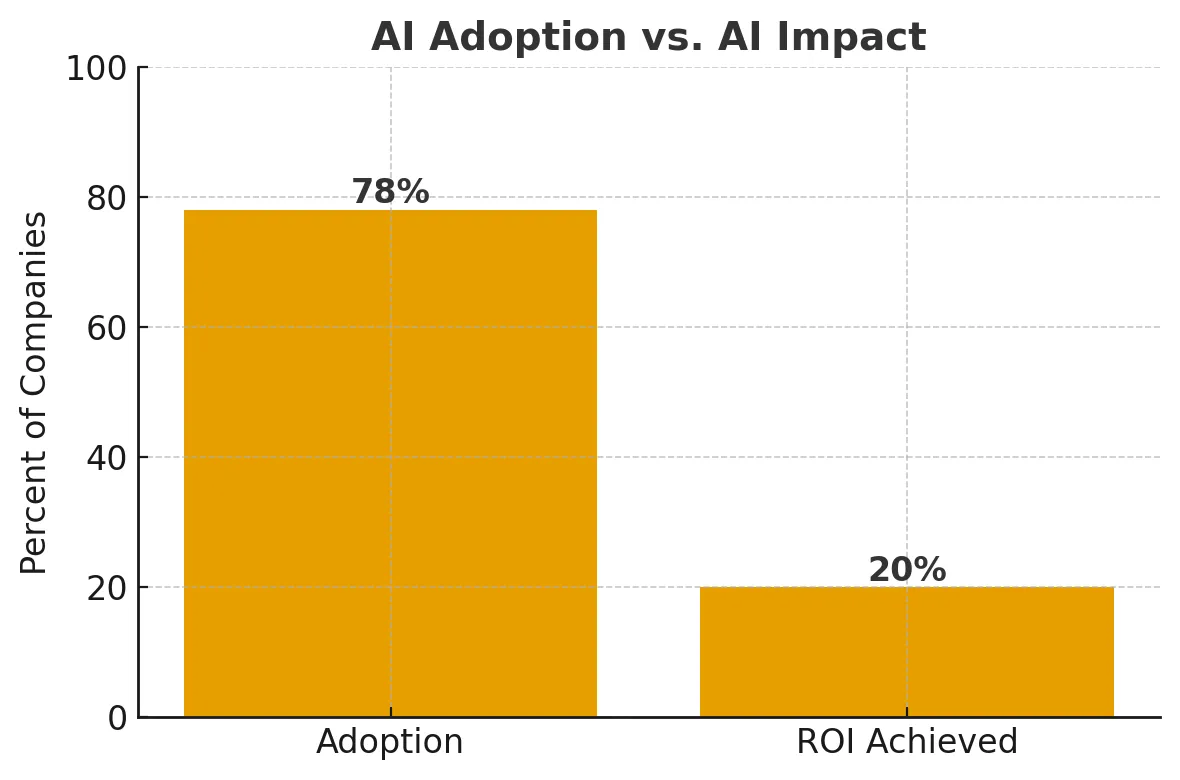
$600B AI Wake Up Call
The $600B AI Wake-Up Call:
Why Strategy, Not Software, Will Separate Winners from the Rest

78% of companies say they’re using generative AI in at least one business function.
80% report no meaningful ROI.
That’s the paradox of AI in 2025: a gap measured in billions. And it’s not because the technology doesn’t work. It’s because most teams are still solving for software instead of solving for the business.
What we’re seeing now is a predictable consequence of adoption without alignment. Companies are deploying copilots, testing pilots, and rolling out tools, but too few are asking the questions that determine whether those efforts lead to actual business outcomes.
They’re trying to solve for a tech problem, when they really have a strategy problem.
What These AI Projects are Missing
Most AI projects never make it out of the pilot phase. McKinsey estimates 90% fail to scale.
The reasons aren’t mysterious:
Tools are selected before the problem is clearly defined.
Use cases are isolated from core business processes.
Teams are siloed, with no shared ownership of success.
Data is fragmented or unusable.
Here’s an example of what that might look like in the real world:
A SaaS firm rolls out a chatbot to support customers. The interface works fine. But adoption stalls because the system can’t access ticket history, the responses aren’t relevant, and support teams weren't trained on where automation stopped and human handling began.
Within weeks of launch, usage began to drop.
Customers were frustrated. The chatbot couldn’t access past tickets or purchase history, so every interaction felt like starting from scratch. No one had clarified when the bot should escalate a case or hand it off. Some reps assumed the bot would filter everything; others kept manually reviewing each chat transcript just in case.
The outcome: The tool “worked,” but it didn’t deliver. Customers opted for live support anyway. Agents were bogged down with rework. And the leadership team was left wondering why an expensive, well-marketed solution hadn’t moved the needle on resolution times or CSAT.
What went wrong? No one paused to map the customer journey, evaluate the data dependencies, or define handoffs. The result was noise.
Why Strategy Has to Come First
Before you invest in a single model or integration, you need to ask:
What problem are we solving?
Where does this live in the broader process?
Who owns the result?
Is our data ready to support this?
How will we measure success?
When companies skip these questions, they create expensive experiments. When they answer them, they build systems that scale.
This is where the winners are starting to separate themselves.
What the Winners Are Doing Differently
In organizations where AI is actually driving results, we’re seeing a few consistent patterns:
AI is aligned to business priorities. They’re not launching experiments. They’re solving for specific KPIs: time to resolution, pipeline velocity, margin per transaction.
Process comes before platform. Instead of force-fitting tools, they map workflows end-to-end and define the outcomes first.
Governance is not an afterthought. They’re asking hard questions up front about risk, roles, and integration. What’s more, they’re setting guardrails before rollout.
They focus on enablement, not just automation. The best teams use AI to extend human capability, not replace it. They design for co-piloting, not sidelining.
The Cost of Getting It Wrong
When AI is misaligned, the impact isn’t just financial.
Executives lose trust in transformation teams, which takes time to build back.
Talent disengages after tools fail to deliver.
Teams burn cycles chasing fixes instead of outcomes.
And meanwhile, competitors who start slower but build with intention are quietly outpacing you.
What We Help Solve
One of the most important things I do in my work is to help tech leaders slow down just enough to ask better questions:
Is your AI effort connected to something that matters?
Is your data architecture ready?
Who’s accountable for adoption, not just deployment?
And once we’ve done that, we can get focused on real outcomes, not hype.
The Inflection Point Is Here
We’re moving out of the experimentation phase. Boards and executive teams are demanding impact (as well as ROI).
The way to win is not to implement AI first. It’s to align it best.
If your AI investments aren’t paying off, or you’re not sure where to begin, DM me. I’m working with a small number of executive teams this quarter to make sure their AI investments translate into business results.